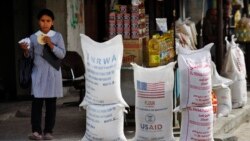Six decades ago, then-President Dwight Eisenhower created the Food for Peace program.The idea was to ship surplus U.S. food to countries that needed help feeding their people.The food relief program eventually fell under the purview of the U.S. Agency for International Development, or USAID. Although no longer a “surplus disposal program” (U.S. food assistance is now bought on the commercial market) USAID remains the largest provider of food assistance in the world.
“For over 60 years, the Food for Peace Title II program has allowed the United States to live up to its historic mission to alleviate hunger around the world,” said Director of Food for Peace, Dina Esposito. “We have fed billions of the world's neediest people - perhaps the largest and longest-running expression of humanity ever seen.”
The need for food assistance is greater than ever, said Director Esposito. Some 800 million are malnourished and remain in a state of food insecurity—not knowing where their next meal is coming from.
Extreme weather, slow economic growth, and high food prices – even the Ebola epidemic in West Africa--are fueling hunger by disrupting agriculture, and pushing millions already in distress, deeper into poverty. Conflict also fuels hunger, and more people are affected by conflict now than at any time since WWII.
The United States feeds the hungry not only because it is the right thing to do, but also because it serves our national security interests: countries with hungry populations are more likely to be politically unstable, providing fertile breeding grounds for rebellions, criminal gangs, or extremist groups.
But even as the need for food assistance rises, so does the cost of providing it. In order to address growing needs in the most effective and cost-efficient manner possible, USAID is changing how it delivers food assistance.
We still provide millions of tons of food directly to those who need it, but now we are buying more food locally, ensuring faster delivery, and helping to support economic recovery in hard-hit communities. Some people may be given debit cards so they can purchase their food. Elsewhere, we address the root of the problem by teaching local farmers more efficient methods of farming, irrigation and animal husbandry, and emphasizing the importance of proper nutrition and dietary diversity.
In the words of Director, Dina Esposito, “We are committed to continuing to find ways to work smarter and better so we can effectively and efficiently combat hunger around the globe.”

















